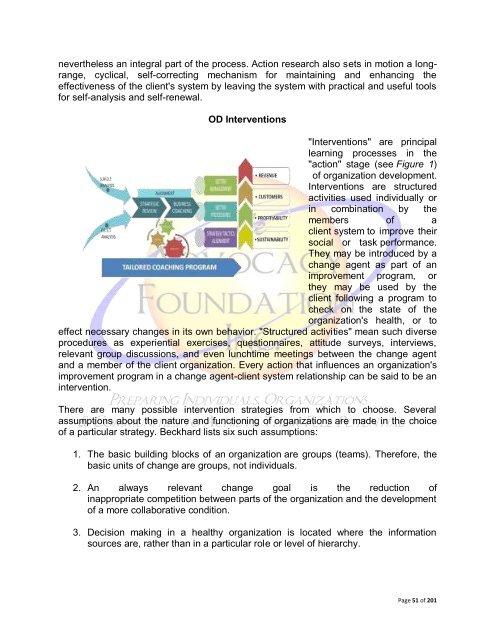ComeUnity CAPACITY BUILDING
ComeUnity CAPACITY BUILDING
ComeUnity CAPACITY BUILDING
Create successful ePaper yourself
Turn your PDF publications into a flip-book with our unique Google optimized e-Paper software.
nevertheless an integral part of the process. Action research also sets in motion a longrange,<br />
cyclical, self-correcting mechanism for maintaining and enhancing the<br />
effectiveness of the client's system by leaving the system with practical and useful tools<br />
for self-analysis and self-renewal.<br />
OD Interventions<br />
"Interventions" are principal<br />
learning processes in the<br />
"action" stage (see Figure 1)<br />
of organization development.<br />
Interventions are structured<br />
activities used individually or<br />
in combination by the<br />
members of a<br />
client system to improve their<br />
social or task performance.<br />
They may be introduced by a<br />
change agent as part of an<br />
improvement program, or<br />
they may be used by the<br />
client following a program to<br />
check on the state of the<br />
organization's health, or to<br />
effect necessary changes in its own behavior. "Structured activities" mean such diverse<br />
procedures as experiential exercises, questionnaires, attitude surveys, interviews,<br />
relevant group discussions, and even lunchtime meetings between the change agent<br />
and a member of the client organization. Every action that influences an organization's<br />
improvement program in a change agent-client system relationship can be said to be an<br />
intervention.<br />
There are many possible intervention strategies from which to choose. Several<br />
assumptions about the nature and functioning of organizations are made in the choice<br />
of a particular strategy. Beckhard lists six such assumptions:<br />
1. The basic building blocks of an organization are groups (teams). Therefore, the<br />
basic units of change are groups, not individuals.<br />
2. An always relevant change goal is the reduction of<br />
inappropriate competition between parts of the organization and the development<br />
of a more collaborative condition.<br />
3. Decision making in a healthy organization is located where the information<br />
sources are, rather than in a particular role or level of hierarchy.<br />
Page 51 of 201

















